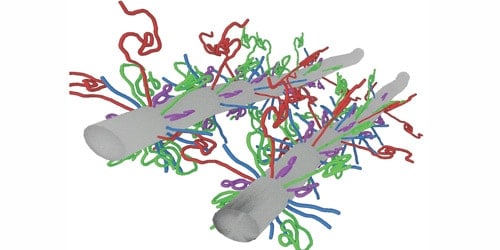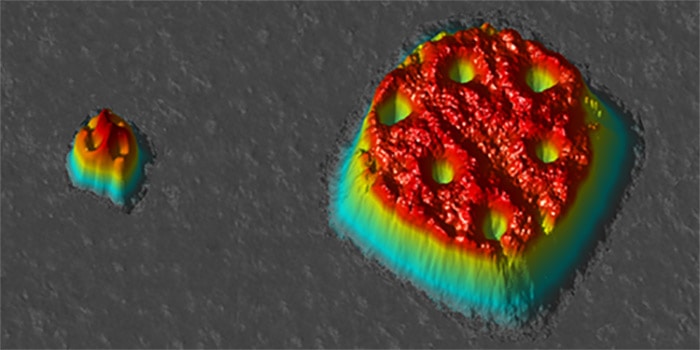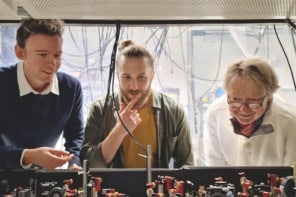Flash Physics is our daily pick of the latest need-to-know developments from the global physics community selected by Physics World‘s team of editors and reporters

Tails help proteins protect the nervous system
A study by physicists at Tel Aviv University in Israel has revealed how some structures act as very efficient shock absorbers to protect the mammalian nervous system. Roy Beck and colleagues have used X-ray diffraction and computer models to study the disordered protein structures that biophysicists know are responsible for absorbing compressive forces in neurone cells. The structures comprise long filaments with protein “tails” sticking out – giving each filament the appearance of a bottlebrush. When subjected to low compressive forces, the filaments are held together in a network by an attractive interaction between the tails. As compression increases, the interaction becomes repulsive and is very effective at absorbing the compressive force. Furthermore, the interaction ensures that the protein filaments remain intact, even after being compressed one twentieth of its original volume. About one half of all human protein structures contain disordered regions and the study – described in Physical Review Letters – could shed light on the biophysics of these systems.
US–Australia sign particle-physics agreement

The Fermi National Accelerator Laboratory (Fermilab) and the ARC Centre of Excellence for Particle Physics at the Terascale (CoEPP) have signed an agreement to deepen their co-operation in particle physics. The initiative – dubbed a co-operative research and development agreement – will result in an exchange of scientists, students and technical staff, as well as the labs working together on accelerator R&D, new computational methods and advances in theoretical physics. “We’re glad to deepen our relationship with CoEPP as we move forward into a new era of physics research,” says Fermilab director Nigel Lockyer. CoEPP director Geoffrey Taylor adds that the “welcome alliance” will lead to the development of new techniques, tools and detector technology in particle physics.
Vortices interact in superfluid mixture

Physicists in China have mixed two superfluids together and then watched as vortices created in one superfluid interact with those created in the other superfluid. The work was done by Xing-Can Yao, Jian-Wei Pan and colleagues at the University of Science and Technology of China, who mixed together fermionic lithium-6 atoms with bosonic potassium-41 atoms. Creating such a superfluid mixture is of great interest to physicists trying to simulate superconductors – with fermions and bosons playing the roles of electrons and phonons, respectively, in a superconductor. The team cooled the atoms and then held the resulting superfluid mixture within a disc-shaped optical trap. Then, a rotating laser was used to spin the mixture, which is able to flow without resistance. When the researchers observed the motions of the two different atomic species, they saw two different lattice-like patterns of vortices (see image). They found that the lithium-6 vortices behaved differently in the mixture compared with when superfluid lithium-6 was studied on its own. This suggests that the two superfluids are interacting with each other. The research is described in Physical Review Letters.
- You can find all our daily Flash Physics posts in the website’s news section, as well as on Twitter and Facebook using #FlashPhysics. Tune in to physicsworld.com to read about today’s announcement of the Nobel Prize for Physics.



